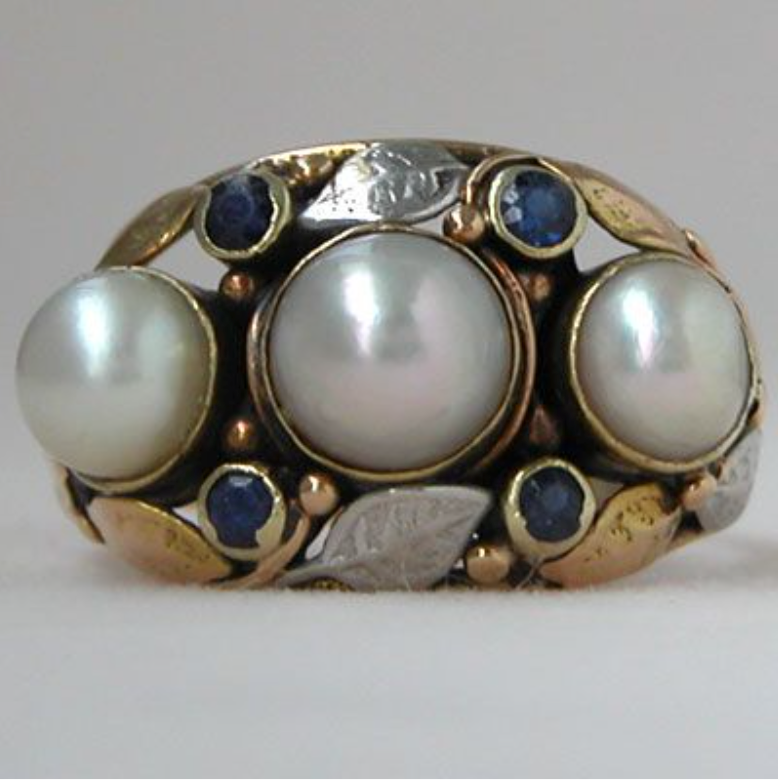
Jewelry Explosion from the Arts & Crafts Movement
Jewelry Explosion from the Arts & Crafts Movement by Morgan Watkins
There’s something about some good old fashion DIY-ing that can give you an overwhelming sense of pride and satisfaction. Getting down and dirty and creating things with your own two bare hands is a process that has fallen to the wayside as big name manufacturers have taken over that role for pretty much the entire world. But with the Arts & Crafts Movement came a surge of do-it-yourself individuals who wanted to take matters, and jewelry making, into their own hands. Want to learn more about this movement and its impact on the jewelry world? Keep on reading!
Starting in the later half of the 19th century, the Arts & Crafts Movement looked to bring back individuality and artistry. This era was comprised of people who saw the newly booming mechanical and industrial revolutions as a means of stripping away creativity and passion from the working class. Guildsman C.R. Ashbee took matters into his own hands and trained his fellow guildsmen on how to create their own handcrafted jewelry. The guild systems in general greatly rejected traditional jewelers and manufacturers, as did those who handmade materials for a living and lost their positions to machine driven factories. In general, the widely believed ideal was that goods should come from the hands of hard working peoples, notfrom cold and cruel factories with horrid working conditions. As jewelry making left factories and entered the household, married couples began making their own unique pieces together. Thanks to this change in dynamics, women were finally able to enter the jewelry industry, where they flourished and thrived. They were successful in designing, enameling and handcrafting arts & crafts jewelry, and often attended crafting and jewelry making classes in their leisure in order to improve on their skills.

While the value of jewelry is often gauged by the quality of materials used, like
gold and platinum, arts & crafts jewelry was regarded more for its unique, one-of-a-kind nature. Characteristically, accessories were assembled with cheaper, less frivolous goods like aluminum, copper, glass, freshwater pearls, and hand painted enamel. Stones, including moonstone, opal, turquoise, and amethyst, also graced arts & craft designs, complimenting the often dainty and delicate silhouettes popular during this time. Gold and precious stones, although rare, were used sparingly to accent more high end arts & craft jewelry pieces.

(Image from https://talkingfashion.net/collections/art-nouveau-and-victorian/products/victorian-antiqu e-art-nouveau-black-brown-confetti-wide-link-vintage-bracelet)
Necklaces, pendants, clasps and buckles were most commonly produced during the age of arts & craft jewelry. Stylistically, designs were quite dainty and elegant, but influence from all over the world trickled into the realm of the Arts & Crafts Movement. Japanese art translated onto tapestries, which featured floral designs and animal outlines which later appeared carved into metal jewelry. The Art Nouveau Era also had an impact on arts & crafts jewelry, which explains the interesting and greatly detailed silhouettes that were born from the late 1800s. Influence from Germany, Britain and even the Renaissance and Gothic periods also emerged during the heyday of handcrafted accessories, adding elements of glitz and glam to everyday pieces in an affordable way.

(Image from https://talkingfashion.net/collections/art-nouveau-and-victorian/products/copy-of-tbf-art-d eco-pearls-rhinestones-pin-brooch-vintage-jewelry)
Unfortunately, arts & crafts jewelry fell out of popularity around the 1920s and 1930s as it was overshadowed by the Art Deco Era. The designs were, then, deemed too fragile for everyday wear, as newer pieces were sturdier and just as affordable. With that being said, arts & craft jewelry is still available all over the web. Regardless of arts & craft jewelry’s simmered popularity, it’s never too late to start handcrafting pieces of your own! But if you would rather leave the DIY-ing to the pro-crafters, sites like Etsy and Poshmark promote creative craftsmanship, where individuals run their own virtual DIY shops. Similarly, talkingfashion.net has a wide array of Art Nouveau and vintage styles to shop around for, including dazzling bracelets and stunning brooches. Be sure to take a look and embrace the fun styles from the Arts & Crafts Movement!
References:
“Arts & Crafts Era Jewelry.” Antique Jewelry University, https://www.langantiques.com/university/Arts_%26_Crafts_Era_Jewelry.
